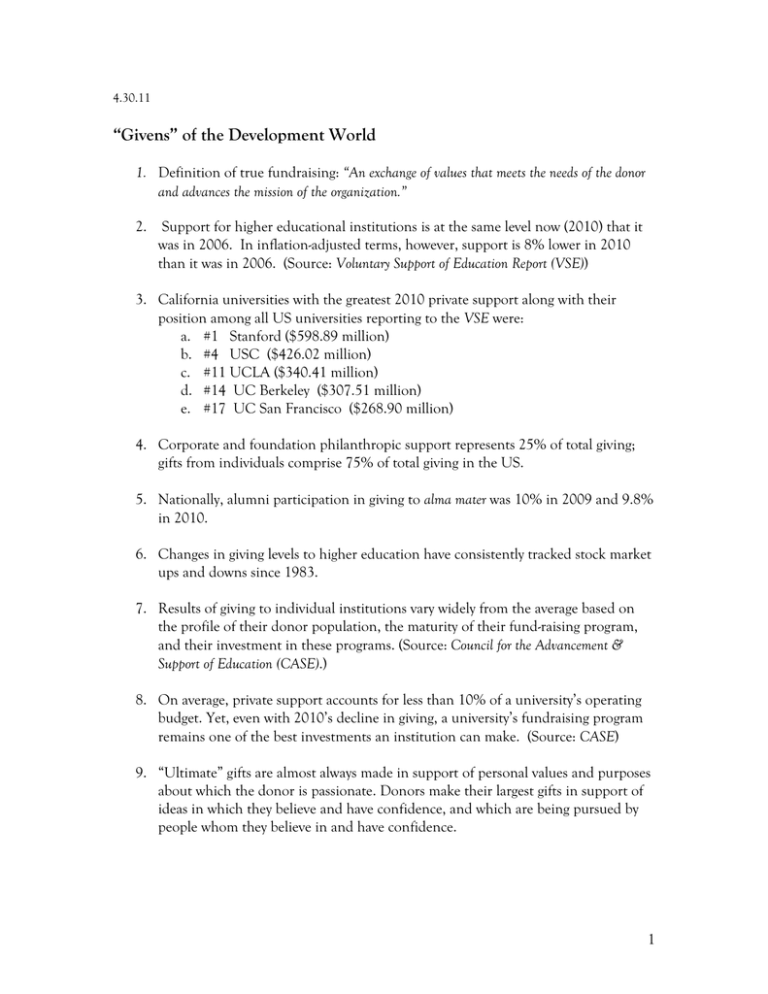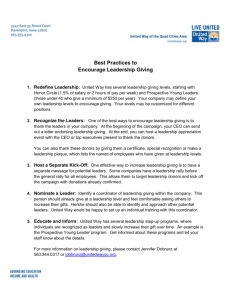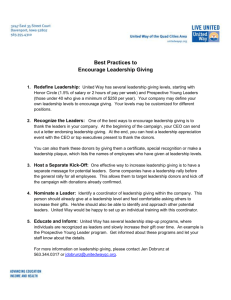“Givens” of the Development World
advertisement

4.30.11 “Givens” of the Development World 1. Definition of true fundraising: “An exchange of values that meets the needs of the donor and advances the mission of the organization.” 2. Support for higher educational institutions is at the same level now (2010) that it was in 2006. In inflation-adjusted terms, however, support is 8% lower in 2010 than it was in 2006. (Source: Voluntary Support of Education Report (VSE)) 3. California universities with the greatest 2010 private support along with their position among all US universities reporting to the VSE were: a. #1 Stanford ($598.89 million) b. #4 USC ($426.02 million) c. #11 UCLA ($340.41 million) d. #14 UC Berkeley ($307.51 million) e. #17 UC San Francisco ($268.90 million) 4. Corporate and foundation philanthropic support represents 25% of total giving; gifts from individuals comprise 75% of total giving in the US. 5. Nationally, alumni participation in giving to alma mater was 10% in 2009 and 9.8% in 2010. 6. Changes in giving levels to higher education have consistently tracked stock market ups and downs since 1983. 7. Results of giving to individual institutions vary widely from the average based on the profile of their donor population, the maturity of their fund-raising program, and their investment in these programs. (Source: Council for the Advancement & Support of Education (CASE).) 8. On average, private support accounts for less than 10% of a university’s operating budget. Yet, even with 2010’s decline in giving, a university’s fundraising program remains one of the best investments an institution can make. (Source: CASE) 9. “Ultimate” gifts are almost always made in support of personal values and purposes about which the donor is passionate. Donors make their largest gifts in support of ideas in which they believe and have confidence, and which are being pursued by people whom they believe in and have confidence. 1 10. US Trust Survey of Affluent Americans (2002) concluded that philanthropic motivation (a) is highly personal, (b) often increases with experience, and (c) is usually positive. 11. In the first 14 seconds of a meeting with a prospect, the donor makes 38 decisions. a. 7% are based on what is actually said b. 38% are based on voice tone c. 55% are conveyed by non-verbal, visual signals After 48 hours, the donor remembers 76% of what they (the donor) said and only 37% of what the development officer said! (“Egos & Eggshells, Margot Robinson) 12. US Trust survey of “Motivation for Giving” among the top 1% of wealthiest Americans revealed the following hierarchy of motives: a. Desire to support worthy causes b. Responsibility to share good fortune c. Meet community’s crucial needs d. Help an organization that benefitted self or family e. Set example for children f. Fill gaps left by government g. Tax benefits h. Respect and recognition i. Pressure from peer or acquaintances 13. The top 1% of wealthiest Americans give an average of 8% of their after-tax income to charity. This compares with less than 3% of after-tax income for the general population. 14. The age demographics for individuals with a bequest in place: Age 30-39 8.9% Age 40-49 28.1% Age 50-59 21.9% Age 60-69 20.6% Age 70-79 11% Age 80+ 8.9% The age demographics for those willing to consider a bequest: Age 30-39 18% Age 40-49 28% Age 50-59 24% Age 60-69 5% Age 70-79 3% Age 80+ 1% (Source: Indiana University Center for Philanthropy) 2 15. A Fidelity Gift Fund study reveals that 52% of donors age 25-39 plan their annual giving. 26% of this group reported that their parents influenced their behavior. 16. 80 – 85% of planned gifts are revocable. Thus the work is not over when a gift document is signed! 17. Why do individuals give? a. Impact b. Outcomes c. Immediacy 18. What do donors want in exchange for their gifts? a. Prompt, personalized acknowledgement of their gift b. Confirmation that their gift has been set to work as intended c. Measurable results of their gift at work prior to being asked for another contribution. What do most charities provide instead? a. Form letter acknowledgement of gift b. No indication of how gift is being used c. No measurable results on their gift d. Frequent solicitation with no accountability 19. It requires 4.5 times more effort to acquire a new donor than to get a renewed gift. 20. 27% of donors forget that they have even made a gift! 19% of donors think their gifts don’t matter. Thus the importance of “thanking” donors 7 times per year. 21. 97% of gift dollars come from 1.7% of the total donors. 22. People give 3 times as much over the Internet as they do by mail. Average gifts are higher from on-line donors using American Express rather than VISA or MasterCard. 23. Importance of collecting cell phone numbers from students: many will never change their cell phone number. Currently 33% of the US population does not have a landline. 24. The top 1% of wealthiest Americans control 52% of the wealth; the top 20% of wealthiest Americans control 83% of the nation’s wealth. 3 25. Six different personalities of major donors: a. Altruists: Doing good feels right b. Devout: Doing good is God’s will c. Communitarian: Doing good makes sense d. Investor: Doing good is good business e. Repayer: Doing good in return f. Socialite: Doing good is fun 26. Individuals contribute 75% of dollars contributed annually in the US 27. “Rule of thirds” for major gifts: a. One prospect will give nothing b. One prospect will give a token gift c. One prospect will give what you ask 28. Except for high-income taxpayers, the charitable deduction has little value as a motivator for philanthropy. In California, only 39.94% of returns were itemized (for incomes of $50,000 and less, only 19.43% itemized). There are only 10 states where more than 40% of tax returns itemize (MD, NJ, CT, DC, CO, MN, OK, MA, VA, UT). Itemization is highest among high-income taxpayers as well as in states with high home values and high state and local taxes. (Source: IRS) 4


